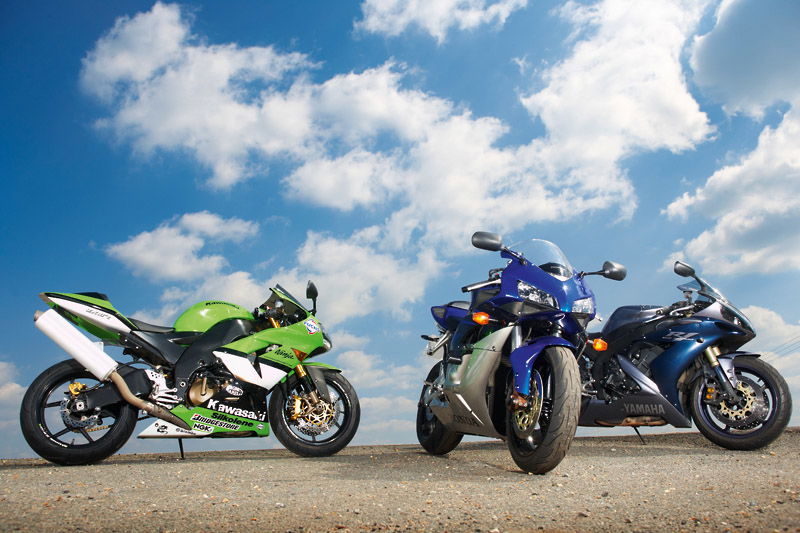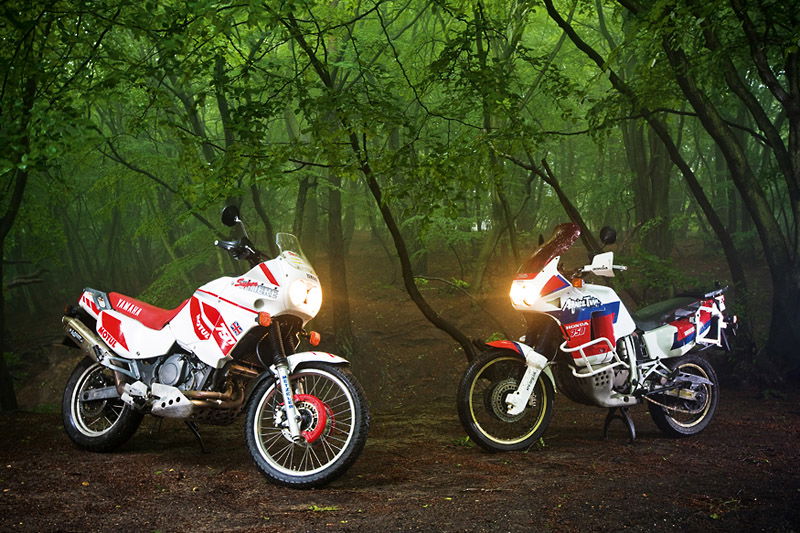Modern Rockers: Triumph Thruxton, Ducati GT1000, Moto Guzzi V7
Classic styling for these retro inspired modern bikes, Triumph, Ducati and Moto Guzzi all have what it takes. But who's got it licked?

Ducati GT1000
Click to read: Ducati GT1000 owners reviews
It’s got the right name on the tank and it’d be nice if it didn’t handle like a tank. Ducati has worked hard to make this bike work well and look half-decent. It IS nice – and you can still get a new one too
Out of the three Sport Classics the GT1000 is by far and away the most satisfying to own and in many ways is the best retro bike on the market for riders who want the grace and style of a classic, yet don’t want to sacrifice performance and handling. While you may be tempted by the half-faired 1000S or café racer 1000 they have their limitations and both are cripplingly uncomfortable to ride due to their low clip-on bars, and this is despite Ducati altering their design after a few years in an effort to appease buyers. The GT1000 has none of these issues, its high bars provide a relaxed riding position while the gigantic seat (adorned with a period Ducati logo) cushions your backside and even provides ample pillion provisions.
On the face of it the GT1000 looks like a bike that could be all style and no substance. The aesthetics of the Ducati are spot on and a lot of work has gone into making it look right. The Pirelli tyres are a modern compound with a special retro tread pattern cut into them, the GT comes in a range of muted yet cool colours (the olive green is beautiful) and little touches such as the analogue dials, chrome horn covers, slotted side panels, twin chrome pipes and bullet indicators are all in keeping with the period. But blended in with all this retro cool are modern components aimed at enhancing not only the ride but also the bike’s sporty edge.
Unlike Triumph Bonneville range (pre-2010 update) the spoke wheels are sportsbike standard fat 17-inch items, the forks inverted 43mm Marzocchis and the engine is Ducati’s 1000cc air-cooled V-twin, one of the most under-rated engines on the market. While it comes with the traditionally heavy Ducati clutch action this is quickly forgotten about as the two valve per cylinder engine provides fierce low down stomp and the kind of acceleration completely unexpected from such a graceful machine. The GT1000 is a wolf in sheep’s clothing.
It’s a bike with emotions. You can feel the V-twin engine throbbing, it has the soul and sound of a Ducati, yet it also has the performance of a modern bike rather than a disappointing and wobbly ride. The handling is almost as good as any contemporary naked bike such as the Speed Triple or CB1300 yet the Ducati has a beauty and attention to detail when it comes to styling that others lack.
While Ducati has pruned the other bikes from the Sport Classic range the GT1000 remains in its line up.
Ducati GT1000 Essential Info
Prices
From £4,700 (2007, 5,000 miles) to £7,400 (2010, 0 miles)
Classic Ducatis are a dangerous minefield when it comes to buying used, but the GT1000 makes an excellent modern alternative to these by having all the old school looks, without the worrying reliability record. With the GT1000 only having been around for a handful of years, and with it being something of a niche machine it means there isn’t much of a choice secondhand While this could put some off, the GT isn’t the type of bike to be allowed to rot over winter, with most of them having yet to see 5,000 miles. If it’s not mint then walk away.
Instant upgrades
- Rear Hugger: The GT1000 divides opinion amongst many who think the back end looks out of proportion to the front. A simple fix to this is to fit a new rear hugger that is closer to the rear wheel and also does a better job of keeping road crap off the bike (especially the battery). From £105.75 (www.worldofqbcarbon.com).
- Gearing: Some owners like to make a small but effective alteration to the gearing of the GT, to lower it giving better acceleration and a lower cruising speed. The 15 tooth front sprocket can be replaced by a 14 for the desired effect. £15.94 (www.wemoto.com).
- Exhaust: It would be a crime for a bike this retro to not have a retro soundtrack to go with the looks. For a Ducati, the obvious choice is Termignoni and they can dutifully supply a pair of slip on end cans. Although the price is a bit salty they definitely add an extra element to the bike, making it even more of a pleasure to ride. Around £970 (www.ducatiperformance.com).
Parts costs
Front indicator: £22.47
Headlight assembly: £195.40
Front brake lever: £79.99
Service costs
Minor: £205
Major: £450
Common faults
The only common complaint from owners is the spoked wheels suffer from corrosion, although this is most likely due to them being more difficult to thoroughly clean than standard wheels. The electrics stand up to scrutiny with only the odd problem of water in connectors from very few owners. There are a few niggles that some complain about, such as Ducati’s traditionally heavy clutch, but the bike is mechanically sound, as it should be considering its lack of years. Pretty dependable on the whole.
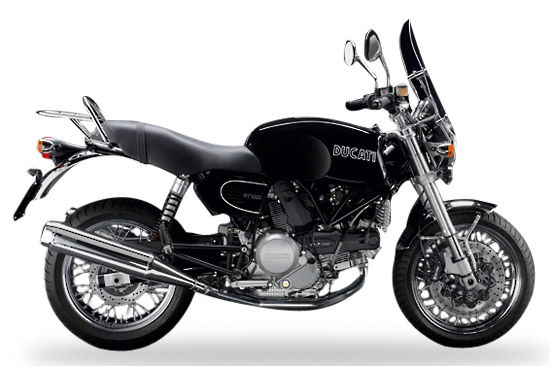
Moto Guzzi V7
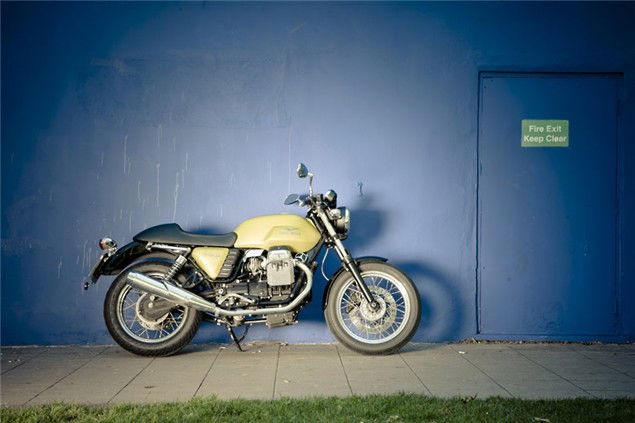
Moto Guzzi V7
Click to read: Moto Guzzi V7 owners reviews
It’s not very powerful, but it’s neat and tidy with obvious nods to Guzzi’s illustrious history. Plain, simple and gently understated, each component blends to make the whole an unexpected pleasure
Based in Mandello del Lario on the shores of Lake Como in Italy the Moto Guzzi factory is steeped in history, not to mention its fair share of financial difficulties. Like any good Italian bike manufacturer Guzzi has had more cash flow problems than Northern Rock but the company has refused to roll over, mainly due to an intensely passionate work force and solid fan base.
Now, with a fresh injection of cash from parent company Piaggio, a whole new air of expectation is surrounding the factory and there is a real buzz about this historic brand. With new money comes new models and last year Guzzi unveiled the V7, a bike inspired by the 1968 V7. Drawing its name from the capacity of the engine the new bike may be a shade over 700cc (it’s actually a 744cc) but that doesn’t detract from its character. This is a classic Guzzi in every way, from the iconic eagle logo to the cylinder heads of the transverse V-twin engine protruding from either side of the bike. But this is a classic aimed at a different audience, it isn’t aimed at older riders looking to relive their youth, the V7 hopes to bring new, fashion conscious, riders to the brand. It’s an unintimidationg, stylish and fun bike that you don’t necessarily need to know all the history of the company to enjoy. And you will enjoy the V7.
Push the starter and the V7 gently rocks from side to side with the motion of the crank as the exhausts burble away behind you. It feels like a bike should, mechanical and full of large lumps of metal flying around inside the engine, alive and full of the spirit of Guzzi.
The transverse engine makes a fairly meagre 48bhp but riding the V7, like the Bonneville, isn’t about going fast, it’s about the ride. Every component does its job without fuss, leaving you to relax and enjoy the feeling and emotion of the journey as well as the gentle pulses from the transverse motor. Like the Triumph the Guzzi aims to emulate its predecessor without any of the associated foibles, the brakes, suspension and engine all do their job, but their biggest strength is the fact you don’t notice them, such is the balance of the overall package
Off the bike and Guzzi fans will spot the nods towards the classic V7. The ‘heel and toe’ rear brake and gear levers, the classically styled dials (stolen from the Ducati Monster), the bold Moto Guzzi logo on the rear of the large seat and the odd-sized wheels, it all gels into a charming machine.
Moto Guzzi V7 Essential Info
Prices
From £4,300 (2008, 6000 miles) to £6,700 (2010, 0 miles)
Guzzi has had something of a bad reputation recently with their money troubles and notorious parts service, but if the V7 is anything to go by, they still make some damn funky motorcycles. The V7 is an absolutely stunning creation, and would look perfectly at home cruising the sun drenched streets of any Italian town. It oozes quality all over, and again will have very few miles on the clock so buyers can be sure they’re getting a well looked after bike. There seems to be quite a range of prices on the V7, so take some time to look around.
Instant upgrades
- Exhaust: CTo bring back the thumping sound from the Guzzi’s of old, stick on an aftermarket exhaust. Few people would complain about the volume of a bike when it sounds this good, bringing back the memories of 60’s Guzzi’s thumping down the street. Termignoni can supply one for £715.99 (www.maxmoto.co.uk).
- Panniers: The most stylish way to tour around would be on a Guzzi V7, so add some sports style panniers to help carry all the luggage you need. The Famsa Sports Small Panniers perfectly suit the style of the V7 and aren’t unobtrusively large. £162.50 (www.windingroads.co.uk).
- Tyres: While super sticky track biased tyres would be wasted on a machine like this, it’s still worth getting some grippy and long lasting tyres that’ll work well in all conditions. Dunlop’s Arrowmax GT501 is specifically designed for bikes like the V7, and offer all the grip the rider needs in the wet or the dry. Around £150 (www.dunlopmotorcycle.eu).
Parts costs
Front indicator: £24.97
Headlight assembly: £146.89
Front brake lever: £22.30
Service costs
Around £330. Valve clearances checked at every 4,750 mile service.
Common faults
Moto Guzzi appears to be having a resurgence when it comes to build quality. Owners of its modern machines are very happy with their reliability, and the V7 is no exception. The only problem regularly raising its head is a rogue fuel injection light apparently randomly coming on. When this does happen, Guzzi says there is nothing wrong with the bike; it is caused by electrical interference so there’s no need for owners to panic. Being such an under stressed machine, the V7 suffers from very few faults.
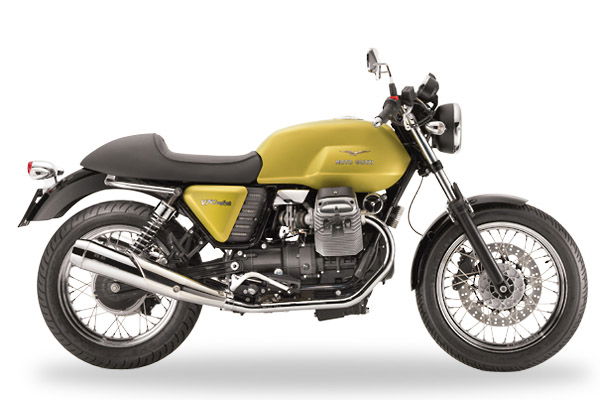
Triumph Thruxton
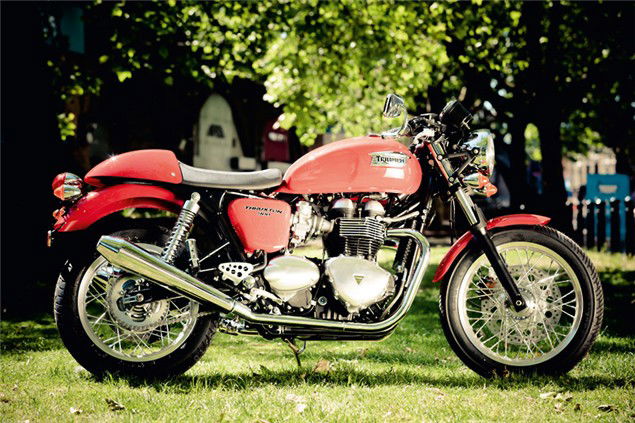
Triumph Thruxton
Click to read: Triumph Thruxton owners reviews
Hinckley has become a hotbed of retro expertise and no bike exemplifies this better than the Thruxton – racy, yet relaxed and cool without being contrived, it’s perhaps the best Bonnie yet...
Turn the ignition on and rather than enter unarmed combat with a kickstart that will attempt to fire you into orbit, the new generation of Bonnevilles require the lightest touches on the starter button to get them purring into life. There is no fight, no cursing at fouled plugs (although some still have a fuel tap to catch out the unwary) and most importantly no oil spewing onto your boot. The air-cooled parallel twin engine sits there idling at constant revs, meekly waiting for your attention.
Sit on it and like the Ducati everything feels and looks period. The clocks are analog, the mirrors shaped in a retro fashion and even the seat has stitching while the tank carries the famous logo on an attached chrome badge. It not just styled to remind you of the Bonnevilles of the 1960s, it’s designed to be, and feel, just like one of them, but without the associated traumas.
On the go the parallel twin engine delivers a spirited if not rapid ride, but this isn’t a bike designed to intimidate, it’s a bike to enjoy. Relax and enjoy. Feeling plays a huge part in Thruxton ownership and not only does every shop window give you the chance to catch a sneaky glance at how cool you look, Triumph has designed the engine specifically to give the rider a buzz and add sensation.
The 865cc parallel twin in the Bonneville and Thruxton has a 360-degree firing interval to deliver a smooth and flowing engine feel while the Scrambler has a 270-degree uneven firing interval to create slight vibrations and an irregularsounding exhaust note for a more characterful ride. It may only make a slight difference to the feeling of a bike, but with Triumphs the clever parts are in the finer details of the bike and it’s the sum of these small parts that makes them.
How dedicated is Triumph to ensuring their retro range look perfect? Just look at the latest models. In 2009 Triumph was forced to stop using carbs as they were deemed environmentally unfriendly by the emissions people. But rather than simply stick injectors on, Triumph designed injector covers that look identical to carbs so that owners wouldn’t spot the change. It’s touches like this that makes Triumph what it is today. You don’t buy a Thruxton to ride at breakneck speed all over the place, you buy one to sample the pure sensations of motorcycling, the feeling of being on two wheels and the memory of biking in the 1960s without the associated aggravation.
Triumph Thruxton Essential Info
Prices
From £3,999 (2005, 4,200 miles) to £6,000 (2010, 1,200 miles)
As with all of these bikes, mileages are very low, keeping prices keen, and considering the performance compared to more ‘modern’ bikes they might be lacking a little for faster riders. The look of the Thruxton is hard to beat though, and given the reliability advantages over older machines makes it worth a look.
Instant upgrades
- Exhaust:While the looks of the Thruxton are spot on for classic cool, unfortunately due to modern noise emission regulations the sound leaves a lot to be desired when it comes to matching the original bikes. Triumph has a vast catalogue of accessories for their machines, and they can supply more aurally pleasing pipes for £311.99 (www.triumphmotorcycles.co.uk).
- Fly screen: The Thruxton is a great looking café racer homage, but the lack of wind protection can be a little impractical for longer jaunts. Adding a flyscreen can give the bike a bit more practicality in this area. Triumph Online offer a screen that is well in keeping with the overall look of the machine for £69.99 (www.triumph-online.co.uk).
- Panniers: A classic style machine such as Triumph’s Thruxton probably isn’t the ideal long distance machine, but cruising along on a gentle a cool bike is a very pleasing way to pass the miles. The easiest way to carry a decent amount of gear when travelling is to stick some panniers on. Again, Triumph’s accessory catalogue caters for this with a set of Sports Panniers for £135.99 (www.triumphmotorcycles.co.uk).
Service costs
Front indicator: £33.71
Headlight assembly: £195.98
Front brake lever: £39.62
Service costs
Minor: £160
Major: £300
Common faults
Overall problems are very rare, unlike the original machines from the ’60s and ’70s. The biggest issue owners reported was with the suspension, which many believe to be under-damped for a machine with sporting intentions. Some replace with high end units with a greater range of adjustment and some go for stiffer springs at the front to cure a wallowing in the corners. Other small issues were discolouring of the exhaust headers and small parts and fasteners corroding if the bike is used in all weather.
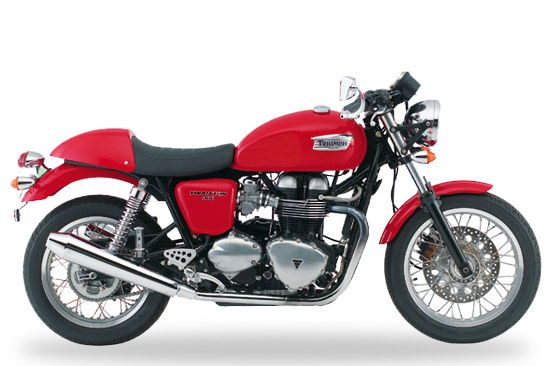
Verdict
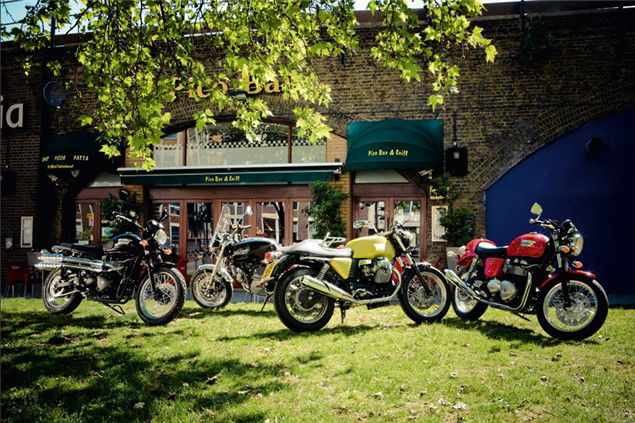
These machines are reliable facsimilies of what were masterpieces of engineering for their times – but which are now compromised as everyday propositions. If you want to invest in a ‘real’ classic then thare are plenty around, but the good ones – either original and unreliable, or sorted and changed almost beyond recognition are expensive now. The days of picking up original Thruxton Bonnevilles or Guzzi V7s for buttons are long gone.
This makes these semi-authentic tributes much more appealing. It’s the looks and reliability that seal the deal. None of these bikes is going to any more or less of an effort to own than a modern machine with modern looks. What your buying decision will come down to is which chunk of history and which look you want to mimic.
The Thruxton offers all the café racer kudos you could want, but its not quite fast enough to walk the walk. Its suspension is not the greatest either. If you want to ride it as fast as it looks then you’d have to spend money on it. The Guzzi is perhaps the cleanest replica of the lot. And a soft, undemanding thing to ride. It’s not at all fast, but it’s not pretending to be, so that’s incidental. It’s also easy to run with shaft drive, a simple engine and unfussy cycle parts that won’t demand constant attention. The most practical of the three.
This leaves the GT1000, undeniably impressive, the most capable of the three in modern company and with the current high brand value of the Ducati badge. The GT tribute bike takes it then.
